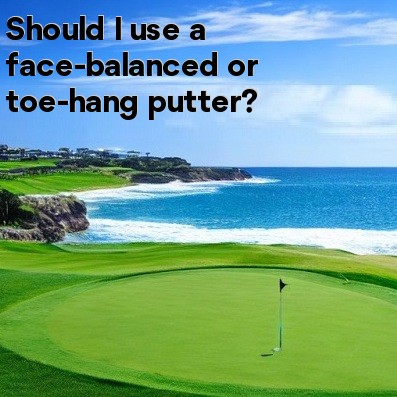
In golf, Should I use a face-balanced or toe-hang putter?
When it comes to choosing a putter, one of the most important factors to consider is the balance of the putter head. There are two main types of putter balance: face-balanced and toe-hang. Both have their advantages and disadvantages, so it's crucial to understand what each means and how it can affect your putting stroke.
- Face-Balanced Putters:
A face-balanced putter is designed in such a way that the face remains perpendicular to the ground when the putter is balanced on your finger. This means that the center of gravity is located towards the back of the putter head, aligning with the shaft. Face-balanced putters are typically best suited for players who have a straight-back and straight-through putting stroke, also known as a “pendulum” stroke.
The advantage of a face-balanced putter is that it helps to keep the putter face square throughout the stroke, promoting a consistent and stable putting motion. This can be particularly beneficial for those who struggle with keeping the face square during their stroke. Face-balanced putters are also generally better suited for players who have an arc-less putting stroke.
- Toe-Hang Putters:
A toe-hang putter, on the other hand, is designed with the center of gravity located more towards the toe of the putter head. This causes the toe of the putter to hang down when the putter is balanced on your finger. Toe-hang putters are ideal for players who have an arcing putting stroke, where the putter swings more inside-to-square-to-inside.
With a toe-hang putter, the weight distribution promotes a natural toe-rotation during the stroke, which can help players with an arcing stroke to square the face at impact. This type of putter is also beneficial for golfers who prefer a more “handsy” feel and those who are comfortable with manipulating the face angle throughout the stroke.
- Choosing the Right Putter Balance:
Ultimately, the choice between a face-balanced or toe-hang putter depends on your putting stroke and personal preference. It's important to understand and evaluate your stroke type before making a decision. If you have a straight-back and straight-through stroke with minimal face rotation, a face-balanced putter may be the better option. Conversely, if you have an arcing stroke and prefer a more hands-on approach to putting, a toe-hang putter may suit you better.
Additionally, it's always a good idea to try out different putter models and see how they feel and perform for you. Experimenting with different balances, grip styles, and head designs can help you determine the putter that gives you the most confidence and consistency on the greens.
In conclusion, whether you choose a face-balanced or toe-hang putter will ultimately come down to your putting stroke and personal preference. It's essential to understand your stroke type and evaluate different putter options to find the best fit for your game. Remember, selecting the right putter is a critical aspect of improving your putting performance and lowering your scores on the golf course.





